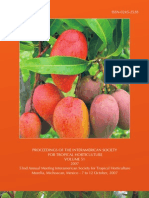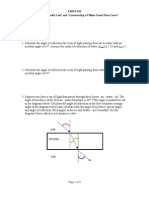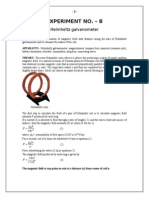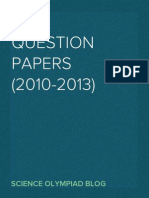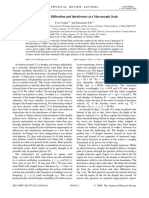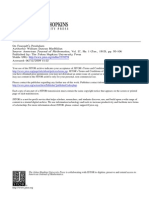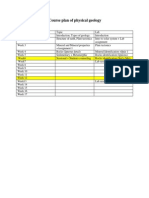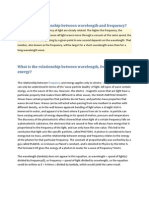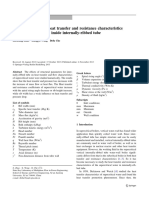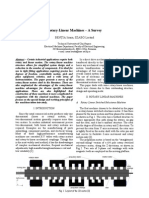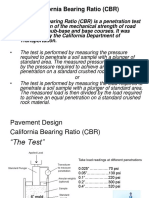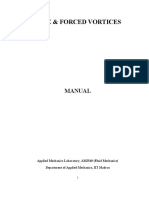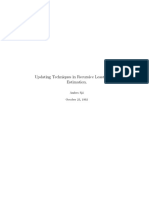0 ratings0% found this document useful (0 votes)
52 viewsEAS-450 - Physics and Chemistry of The Earth Lab Exercise - Focal Mechanisms
EAS-450 - Physics and Chemistry of The Earth Lab Exercise - Focal Mechanisms
Uploaded by
Mohsin Tariq1. This lab exercise involves determining earthquake focal mechanisms through analysis of seismic station data and graphical methods. Students will analyze data from a 1990 earthquake in Turkey and determine the fault plane orientations and type of faulting.
2. Students will then examine the regional tectonic setting around the earthquake, locate major faults in the area, and use additional focal mechanisms and earthquake distributions to infer relative block motions and compare to GPS measurements.
3. As part of the analysis, students must produce a schematic map showing their observations of block motions and relationships to the major active faults in the Eastern Mediterranean region.
Copyright:
© All Rights Reserved
Available Formats
Download as DOC, PDF, TXT or read online from Scribd
EAS-450 - Physics and Chemistry of The Earth Lab Exercise - Focal Mechanisms
EAS-450 - Physics and Chemistry of The Earth Lab Exercise - Focal Mechanisms
Uploaded by
Mohsin Tariq0 ratings0% found this document useful (0 votes)
52 views4 pages1. This lab exercise involves determining earthquake focal mechanisms through analysis of seismic station data and graphical methods. Students will analyze data from a 1990 earthquake in Turkey and determine the fault plane orientations and type of faulting.
2. Students will then examine the regional tectonic setting around the earthquake, locate major faults in the area, and use additional focal mechanisms and earthquake distributions to infer relative block motions and compare to GPS measurements.
3. As part of the analysis, students must produce a schematic map showing their observations of block motions and relationships to the major active faults in the Eastern Mediterranean region.
Original Description:
EAS450_lab6_focmec
Original Title
EAS450_lab6_focmec
Copyright
© © All Rights Reserved
Available Formats
DOC, PDF, TXT or read online from Scribd
Share this document
Did you find this document useful?
Is this content inappropriate?
1. This lab exercise involves determining earthquake focal mechanisms through analysis of seismic station data and graphical methods. Students will analyze data from a 1990 earthquake in Turkey and determine the fault plane orientations and type of faulting.
2. Students will then examine the regional tectonic setting around the earthquake, locate major faults in the area, and use additional focal mechanisms and earthquake distributions to infer relative block motions and compare to GPS measurements.
3. As part of the analysis, students must produce a schematic map showing their observations of block motions and relationships to the major active faults in the Eastern Mediterranean region.
Copyright:
© All Rights Reserved
Available Formats
Download as DOC, PDF, TXT or read online from Scribd
Download as doc, pdf, or txt
0 ratings0% found this document useful (0 votes)
52 views4 pagesEAS-450 - Physics and Chemistry of The Earth Lab Exercise - Focal Mechanisms
EAS-450 - Physics and Chemistry of The Earth Lab Exercise - Focal Mechanisms
Uploaded by
Mohsin Tariq1. This lab exercise involves determining earthquake focal mechanisms through analysis of seismic station data and graphical methods. Students will analyze data from a 1990 earthquake in Turkey and determine the fault plane orientations and type of faulting.
2. Students will then examine the regional tectonic setting around the earthquake, locate major faults in the area, and use additional focal mechanisms and earthquake distributions to infer relative block motions and compare to GPS measurements.
3. As part of the analysis, students must produce a schematic map showing their observations of block motions and relationships to the major active faults in the Eastern Mediterranean region.
Copyright:
© All Rights Reserved
Available Formats
Download as DOC, PDF, TXT or read online from Scribd
Download as doc, pdf, or txt
You are on page 1of 4
EAS-450 Physics and Chemistry of the Earth
Lab exercise - Focal Mechanisms
Objective: Wave propagation (using Snells law), determination and interpretation of earthquake
focal mechanisms.
Wave propagation
1. Your foot is trapped under a railwa sleeper. You feel the rail vi!rate and then "# s later ou
hear a faint whistle. $he train is coming% &stimate how much time ou have to free
ourself.
". ' ()ra arrives at the core)mantle !oundar with an angle of "*
o
, at what angle does it enter
the core+ Same question for an S)ra.
,. ' ra travels down through the interior of a sphericall laered planet and encouters a laer
that e-tends from ,1## km to ,### km radius. .f the velocities a!ove, with, and !elow the
laer are respectivel 1#, 11, and 1" km/s and the ra was incident to the laer at an angle of
0#
o
, at what angle will the ra leave the laer+
Earthquake focal mechanisms
1raphical method to determine focal mechanisms2
1. (lace a sheet of tracing paper over a thum!tack protruding from the center of an equal)area
pro3ection net (4 Schmidt pro3ection).
". 5ark the north a-is on the tracing paper.
,. 5ark the location of seismic stations and first motion2
a. 5ark the a6imuth of the station on the tracing paper.
!. 7otate the tracing paper to !ring that mark to north.
c. 7ead the take)off angle from the center of the pro3ection towards north.
d. (ut a small circle at that position, solid for dilatational first motion, open for
compressional.
e. 7epeat this for ever seismic station.
0. 8nce all the first motions are plotted, rotate the tracing paper to find a great circle that
separates compressional to dilatational first motions.
*. Without moving the tracing paper, count 9#
o
perpendicular to that plane and mark it as :(
(for pole).
;. 7otate the tracing paper to find the second great circle that separates compressional to
dilatational first motions and, in addition, contains ( (this will ensure that the two focal
planes are perpendicular).
<. 7ead the a6imuth and dip of the two nodal plane.
=. 5ark the position of the ( and $ a-es (the are !oth located in a plane perpendicular to the
nodal planes and make a 0*> with the nodal planes).
$he ta!le !elow give the a6im and take of angle of first motion data recorded at 1* seismic
stations for the &r6incan aftershock of 'pril 1", 1990.
station azimuth take-off first-motion
ALI 220 50 D
ME2 314 66 D
KAN 17 6 D
!A" 22 6# D
E"D 133 77 D
DEM 150 7 D
$I" 121 7 %
%NK 156 7# D
&AN 76 62 %
'EL 327 62 D
$%N 2#0 62 %
E&K 312 62 %
&() 31 62 D
*A2 7# 62 %
M(L 2#7 62 %
!%L 67 62 %
AL) 5# 62 D
$%M 320 62 %
$%2 320 62 D
*A& 30 62 %
*IN 2#5 62 %
+A" 24 62 D
KI, 311 62 %
AK& 24 62 D
&%) 2#5 62 %
1. ?etermine graphicall the focal mechanisn (use Schmidt stereonet attached) and write our
results in the the ta!le !elow2
strike .i/
no.a0 /0ane 1
no.a0 /0ane 2
azimuth /0un1e
'-a2is
)-a2is
". 1iven the seismotectonic conte-t of this earthquake (see figure !elow)2
a. Which is the likel fault plane+
!. What is the tpe of faulting+
c. .s our solution compati!le with the general sense of plate motion in the area as well with
the orientation of the acting fault and the orientation of stress/deformation in the area+
&picentres of aftershocks !etween 5arch "1 and @une 1;, 199" of the 5arch 1,, 199" &r6incan
earthquake, $urke. $he open circles represent the main shock and its strongest aftershock on
5arch 1*, and the open star the analsed aftershock. A1, A" and A, are secondar faults to the
Borth 'natolian Aault (B'A). Clack arrows ) directions of relative plate motion, open arrows )
direction of ma-imum hori6ontal compression as derived from centroid moment tensor solutions
of stronger earthquakes.
,. Dets look at the !igger picture, see figures !elow.
a. Docate the main faults2 Borth 'natolian fault, &ast 'natolian fault, 'egean su!duction,
5armara sea faults, 'egean sea faults, Eaucasus faults, Fagros front, ?ead Sea fault.
!. Gse the focal mechanisms to determine the sense of motion and tpe of fault for each of
these faults.
c. Gse the earthquake distri!ution and the earthquake focal mechanisms to infer the relative
motion of tectonic !locks in that area.
d. Eompare with 1(S measurements.
Your paper must include a schematic map of the area with our main o!servations (arrows
showing !lock motions, etc.)
5a3or active faults and earthquake focal mechanisms in the &astern 5editerranean.
Hori6ontal velocit of geodetic sites measured with 1(S. Ielocities are given with respect to the
&urasian plate.
(figures from 5cElusk et al. @. 1eophs. 7es., "###)
You might also like
- Bob Markansky-Primary Directions 1Document51 pagesBob Markansky-Primary Directions 1Svetlana Kabanec100% (5)
- Earthquake Epicenter LabDocument15 pagesEarthquake Epicenter LabRahman Atthariq0% (1)
- Calculation of Planetary Gear FrequenciesDocument6 pagesCalculation of Planetary Gear Frequenciesdongcsun100% (1)
- IAO 2011 ProblemsDocument22 pagesIAO 2011 ProblemsScience Olympiad Blog50% (2)
- Sonic Log ExerciseDocument1 pageSonic Log ExerciseMohsin TariqNo ratings yet
- ProceedingsDocument290 pagesProceedingsBluesunleaf0% (1)
- ROSE 2013 W1D3L1 Focal MechanismsDocument45 pagesROSE 2013 W1D3L1 Focal MechanismsBuhle JoyNo ratings yet
- Fundamentals of Engineering Seismology: Earthquake Focal Mechanisms (Fault Plane Solutions)Document45 pagesFundamentals of Engineering Seismology: Earthquake Focal Mechanisms (Fault Plane Solutions)HarsanoJayadiNo ratings yet
- Earthquake Seismology PracticalsDocument27 pagesEarthquake Seismology PracticalsbchnumNo ratings yet
- Lab 6 Earthquake Focal MechanismsDocument9 pagesLab 6 Earthquake Focal MechanismsVictor Voltaire Montoya ColonnaNo ratings yet
- Satellite CommDocument15 pagesSatellite CommBrem KumarNo ratings yet
- 1 EQEpicentersDocument17 pages1 EQEpicentersGrim Fandango0% (2)
- IO.5 Elliptically Polarized Light: 1. PurposeDocument5 pagesIO.5 Elliptically Polarized Light: 1. PurposeAaloka GautamaNo ratings yet
- Unesco - Eolss Sample Chapters: Earthquake Ground MotionDocument9 pagesUnesco - Eolss Sample Chapters: Earthquake Ground MotionEba GetachewNo ratings yet
- KaustDocument137 pagesKaustManuel FlorezNo ratings yet
- Simple Seismics - For The Petroleum Geologist, The Reservoir Engineer, The Well-Log Analyst, The Processing Technician, and The Man in The Field 1982Document172 pagesSimple Seismics - For The Petroleum Geologist, The Reservoir Engineer, The Well-Log Analyst, The Processing Technician, and The Man in The Field 1982Stephen FortisNo ratings yet
- Dynamics Lectures 2014Document76 pagesDynamics Lectures 2014Ernst SchramaNo ratings yet
- Two Marks: Unit - I&Ii Basics & Statics of Particles & Equilibrium of Rigid BodiesDocument6 pagesTwo Marks: Unit - I&Ii Basics & Statics of Particles & Equilibrium of Rigid BodiespvnandhaNo ratings yet
- Handout Spin PDFDocument9 pagesHandout Spin PDFombraga1896No ratings yet
- EqDocument30 pagesEqChar CharNo ratings yet
- Pendulum With Springs' Large Oscillations: Joshua Olowoyeye 2115521164Document6 pagesPendulum With Springs' Large Oscillations: Joshua Olowoyeye 2115521164noNo ratings yet
- Part 1: Snell's Law: Your Name: Your PSU Access IDDocument3 pagesPart 1: Snell's Law: Your Name: Your PSU Access IDMark MaoNo ratings yet
- An Inversion PrimerDocument8 pagesAn Inversion Primerlagrima_baNo ratings yet
- Seismic WaveletDocument7 pagesSeismic WaveletStart BackNo ratings yet
- WSM Analysis Guideline Focal Mechanisms PDFDocument12 pagesWSM Analysis Guideline Focal Mechanisms PDFEYNo ratings yet
- Pendulum With Springs' Large Oscillations: Joshua Olowoyeye 2115521164Document6 pagesPendulum With Springs' Large Oscillations: Joshua Olowoyeye 2115521164noNo ratings yet
- 324l4 FMDocument39 pages324l4 FMDhanyaUnniNo ratings yet
- (1 - Seismic Triggering Effect of Tidal Stress - (Ding1983Document17 pages(1 - Seismic Triggering Effect of Tidal Stress - (Ding1983LurzizareNo ratings yet
- Satellite Ques BankDocument10 pagesSatellite Ques BankNeeraja SelvarajNo ratings yet
- Lawrence M. Hull - Mach Reflection of Spherical Detonation WavesDocument10 pagesLawrence M. Hull - Mach Reflection of Spherical Detonation WavesGhoree23456100% (1)
- EART 118 Seismotectonics: MWF D250 9:30-10:40 Am TH D250 2:00-4:00 PMDocument55 pagesEART 118 Seismotectonics: MWF D250 9:30-10:40 Am TH D250 2:00-4:00 PMDina'cupmo RiSna NArisNo ratings yet
- Yuri S. Kivshar Et Al - Vortex-Stripe Soliton InteractionsDocument3 pagesYuri S. Kivshar Et Al - Vortex-Stripe Soliton Interactions23213mNo ratings yet
- Variation of Magnetic Field by Helmholtz GalvanometerDocument7 pagesVariation of Magnetic Field by Helmholtz Galvanometerbestmadeeasy0% (1)
- Two MarkDocument6 pagesTwo MarkpvnandhaNo ratings yet
- Post Stack Acoustic ImpedanceDocument18 pagesPost Stack Acoustic ImpedanceRichard Bonatua RajagukgukNo ratings yet
- Peat8002 - Seismology: Lecture 11: Earthquake Source Mechanisms and Radiation Patterns IDocument33 pagesPeat8002 - Seismology: Lecture 11: Earthquake Source Mechanisms and Radiation Patterns ISaurabh SharmaNo ratings yet
- Science 10 Week 2 Day1 4Document10 pagesScience 10 Week 2 Day1 4milojames235No ratings yet
- Brazil TST 2011Document5 pagesBrazil TST 2011Vishnu SinhaNo ratings yet
- 1978 May 585-596#space Oblique ProjDocument12 pages1978 May 585-596#space Oblique Projhbl3688No ratings yet
- Fundamentals of Seismic Refraction: Theory, Acquisition, and InterpretationDocument156 pagesFundamentals of Seismic Refraction: Theory, Acquisition, and Interpretationolsosa100% (1)
- Love Waves Excited by Discontinuous Propagation of A Rupture FrontDocument15 pagesLove Waves Excited by Discontinuous Propagation of A Rupture Frontmhmmmd.tarekNo ratings yet
- Tsunami Damage Estimation in Manta, Ecuador Using Fragility FunctionsDocument6 pagesTsunami Damage Estimation in Manta, Ecuador Using Fragility FunctionsSharl Noboa TeránNo ratings yet
- IESO Question Papers (2010-2013)Document282 pagesIESO Question Papers (2010-2013)Science Olympiad BlogNo ratings yet
- Chapter No.1 Introduction To PhysicsDocument78 pagesChapter No.1 Introduction To PhysicsAdnan Rais KhanNo ratings yet
- Van D2008Document4 pagesVan D2008ffsoakuiNo ratings yet
- QualifyingExamProblemPhysicsUnivOfPrude 1980 2008 PDFDocument518 pagesQualifyingExamProblemPhysicsUnivOfPrude 1980 2008 PDFkajariNo ratings yet
- ZZ210431440 PDFDocument45 pagesZZ210431440 PDFAJER JOURNALNo ratings yet
- Sample Question Paper Physics (042) CLASS-XII - (2012-13)Document24 pagesSample Question Paper Physics (042) CLASS-XII - (2012-13)Shashank ShekharNo ratings yet
- Seismology - Lecture 2 Normal Modes and Surface Waves: Barbara Romanowicz Univ. of California, BerkeleyDocument60 pagesSeismology - Lecture 2 Normal Modes and Surface Waves: Barbara Romanowicz Univ. of California, BerkeleyC.yrillNo ratings yet
- Single-Particle Diffraction and Interference at A Macroscopic ScaleDocument4 pagesSingle-Particle Diffraction and Interference at A Macroscopic ScaleJhonny Fuentes EscritorNo ratings yet
- On Foucault Pendulum 1Document13 pagesOn Foucault Pendulum 1VoiceHopeNo ratings yet
- Qual Exam Jan2017Document6 pagesQual Exam Jan2017gasperogandhiNo ratings yet
- Solar System ZodiacDocument8 pagesSolar System ZodiacNeilNo ratings yet
- Barnaba Ambiesta 2007Document8 pagesBarnaba Ambiesta 2007rlprNo ratings yet
- Subduction Dynamics: From Mantle Flow to Mega DisastersFrom EverandSubduction Dynamics: From Mantle Flow to Mega DisastersGabriele MorraNo ratings yet
- A Slug Test Is A Controlled Field Experiment in Which The Water Level in A Control Well Is Caused To ChangeDocument7 pagesA Slug Test Is A Controlled Field Experiment in Which The Water Level in A Control Well Is Caused To ChangeMohsin TariqNo ratings yet
- Course Plan of Physical GeologyDocument1 pageCourse Plan of Physical GeologyMohsin TariqNo ratings yet
- Groundwater: CyclesDocument6 pagesGroundwater: CyclesMohsin TariqNo ratings yet
- Driving Values:: OMV Pakistan, ISE Tower, Floor # 15 55-B, Jinnah Avenue Islamabad, PakistanDocument4 pagesDriving Values:: OMV Pakistan, ISE Tower, Floor # 15 55-B, Jinnah Avenue Islamabad, PakistanMohsin TariqNo ratings yet
- Groundwater Pumping Test: Time H 0 Levels RemarksDocument6 pagesGroundwater Pumping Test: Time H 0 Levels RemarksMohsin TariqNo ratings yet
- What Is The Relationship Between Wavelength and FrequencyDocument3 pagesWhat Is The Relationship Between Wavelength and FrequencyMohsin TariqNo ratings yet
- Research On Simulation of Radar Return From Extended Target: Xiaohui Yu, Pengfei LuoDocument4 pagesResearch On Simulation of Radar Return From Extended Target: Xiaohui Yu, Pengfei LuoAlex YangNo ratings yet
- Exoterm Dan EndotermDocument19 pagesExoterm Dan EndotermZakiyahNo ratings yet
- Numerical Study On Heat Transfer and Resistance Characteristics of Supercritical Water Inside Internally-Ribbed TubeDocument14 pagesNumerical Study On Heat Transfer and Resistance Characteristics of Supercritical Water Inside Internally-Ribbed TubeOscar DorantesNo ratings yet
- Rotary-Linear Machines - A SurveyDocument4 pagesRotary-Linear Machines - A Surveyarnika33No ratings yet
- Abstract ISO 1940-1 - 2003Document4 pagesAbstract ISO 1940-1 - 2003PPMNo ratings yet
- Grade 7 Number System StandardsDocument2 pagesGrade 7 Number System Standardsapi-282583504No ratings yet
- ColaMulse EZDocument2 pagesColaMulse EZmndmattNo ratings yet
- Process Modeling, Identificaion and ControlDocument20 pagesProcess Modeling, Identificaion and Controlluisagarcia366No ratings yet
- Characteristics of Collapsi AND BLE Prob Soils Lems: FebruaryDocument23 pagesCharacteristics of Collapsi AND BLE Prob Soils Lems: Februaryศิวาเวช อบมาNo ratings yet
- Earlier MotorDocument23 pagesEarlier MotorAlexander WijesooriyaNo ratings yet
- Research MethodDocument51 pagesResearch MethodTolaz KoyiNo ratings yet
- 02-3 Prime MoversDocument46 pages02-3 Prime Moverssulemankhalid100% (2)
- Module 1Document23 pagesModule 1laloNo ratings yet
- Specs For Graphite in CruciblesDocument16 pagesSpecs For Graphite in CruciblesjleydencoNo ratings yet
- Chemistry ProjectDocument29 pagesChemistry Projectpintu2055No ratings yet
- Linearization SatelliteTrajectoryDocument3 pagesLinearization SatelliteTrajectoryBetaSolDelEsteNo ratings yet
- California Bearing Ratio (CBR)Document18 pagesCalifornia Bearing Ratio (CBR)Usman AfzalNo ratings yet
- Prediction of Milling Force Coefficients From Orthogonal Cutting DataDocument9 pagesPrediction of Milling Force Coefficients From Orthogonal Cutting DataviniciusadsNo ratings yet
- Bosal Holding - Analysis and CritiqueDocument11 pagesBosal Holding - Analysis and CritiqueArdi BaharudinNo ratings yet
- Structural ReviewerDocument18 pagesStructural ReviewerjericoNo ratings yet
- CHE 303 - Chemical Engineering Thermodynamics II / All Sections First Semester 2011 - 2012Document2 pagesCHE 303 - Chemical Engineering Thermodynamics II / All Sections First Semester 2011 - 2012ArielNo ratings yet
- Linear Functions The Equation of A Straight LineDocument5 pagesLinear Functions The Equation of A Straight LineMohan LalNo ratings yet
- Free & Forced Vortices: ManualDocument11 pagesFree & Forced Vortices: ManualMahadevan100% (1)
- Updating Techniques in Recursive Least-Squares EstimationDocument61 pagesUpdating Techniques in Recursive Least-Squares EstimationparticlepersonNo ratings yet
- Ke Product Info 0803Document2 pagesKe Product Info 0803Ricardo RGNo ratings yet
- Sheet 6Document4 pagesSheet 6Abdalla Mohamed Abdalla100% (1)
- Igbt Spice ModelingDocument43 pagesIgbt Spice ModelingBrian WillardNo ratings yet
- Preliminary Design Report (Group 5)Document10 pagesPreliminary Design Report (Group 5)Shubhankit MohanNo ratings yet





